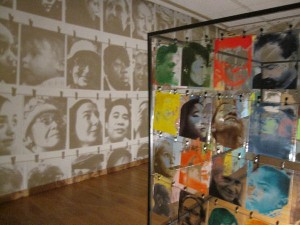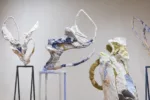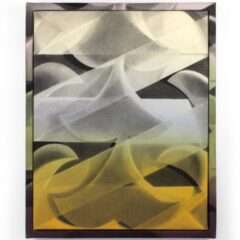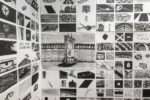Fleisher’s Wind Challenge 1 packs a wallop, as it’s not too often that such heavyweights are gathered together in South Philly. The works of Bohyun Yoon, Ryan Wilson Kelly, and Erin Murray, up through October 20, each bring an entirely unique artistic style to the gallery. (Also, readers: Kelly’s performance piece Mazeppa needs to be seen live to be fully experienced. It was performed at the opening, and will performed again, with an introduction by the artist, on Saturday, October 6, at 4 p.m.)
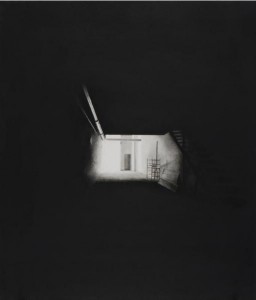
Erin Murray’s graphite drawings of boring Philly buildings are exceptional exercises in intense observation. Her drawings are simultaneously completely flat, yet luminous in variety of shading. Stark black or white backgrounds form a void against which the tamed geometry of her buildings’ lines and angles resonates with the viewer. Murray wrote in her artist’s statement for the show that she is interested in the “abundance of meaning … in structures so ubiquitous and common that they hardly ever get a second glance.” The mundane subjects she chooses add a sly humor to the drawings, which will only yield their treasures after a long gaze.
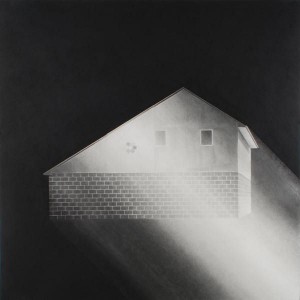
Murray’s series of smaller, 13 x 15 inch pieces, all of which had been sold by the time I stopped by to see the show, are called “untitled abstractions.” But actually, the artist makes very detailed, realistic drawings — so where’s the abstraction? Maybe in her piercing look at these structures, stripping away the boredom and revealing the complexities of the reflections of light or rigid ordered patterns of line. The works seem to suggest the opposite of the unseen, disordered, chaotic “real” world the structures inhabit.
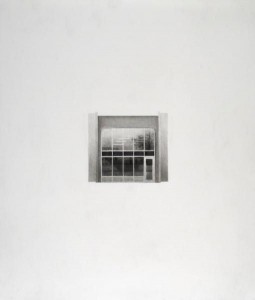
The larger pieces, all measuring 36 x 36 in. and titled to reflect a perspective in time, add strong diagonals that suggest spectrums of light. In “Future,” light either originates in or is captured by the building, whereas in “Future Perfect” (above), the light seems to be shed by the building and directed downwards to the ground in front.
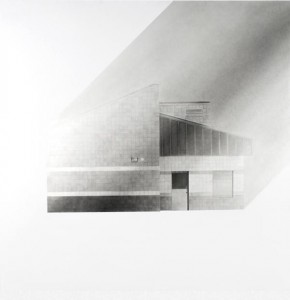
The whimsical sense of humor of Bohyun Yoon is evident in many of his unabashedly pleasing works with glass and mirrors, for example “Glass Tube and Glass Helmet,” a rather musical piece in which Yoon and performers pour water into each others’ helmets, like a brain/fluid exchange. Or take the “Transparent Business Suit” video, in which Yoon walks the streets of Philly in a transparent business suit and then again in an ordinary business suit.
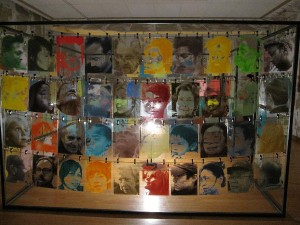
“Neighbors” projects black and white photo blowups of faces of Philadelphians on the gallery walls. In the center of the room, the multi-colored glass plates on which these photographic images of faces are printed are hung in a 3D cube, which is accessible to viewers. A bare light bulb in the middle of the cube creates the wall projections through the glass plates. One reaction to the work is that it is a microcosm of life – the bare light bulb is the sun or life force, which, radiating out through the multicolored glass plates, animates them and makes them “real” by creating the projections on the wall. In this view, each glass is like the soul or individuality of that person.
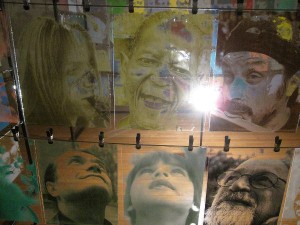
In Yoon’s statement, he says the various colors of glass plates demarcate race and class differences. Not literally – people of one race don’t all get printed in the same color – but metaphorically, each person is a different color. The metal structure on which the plates are hung is a territory or institution. In the monotone projected colorless images, Yoon senses the unity of humanity and allows the detail and uniqueness of each face to speak for itself.
Obviously, the work reflects diversity in the community, and Yoon’s photography captures the “beautiful souls” he has found in Philadelphia, as his statement says. But the work is also enjoyably interactive; one can enter the central structure and watch his/her shadow change each image from transparent and abstract to opaque and comprehensible. Aesthetically, the one-color prints are remarkable for how little these images are made of, in contrast to the complexity of the people and personalities they represent.
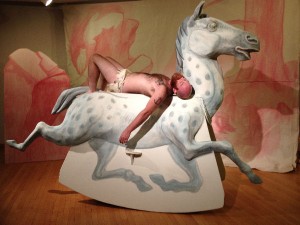
Ryan Wilson Kelly created a new performance piece for Fleisher Wind Challenge 1, shaped around the apocryphal tale of Mazeppa, a Polish noble of the 1600s who had an affair with a count’s wife and was sentenced to death by means of being lashed to a wild horse and dragged through the woods. The legend of Mazeppa was passed down as a folk-tale, appearing in popular painting and an opera by Tchaikovsky, but it was most famously memorialized in a Lord Byron poem, which directly inspired Kelly. The story goes that against the odds, Mazeppa survived the torture, and years later become the “hetman” or leader of the Ukrainian Cossacks
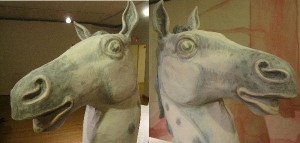
Kelly’s works are simultaneously humorous, fun, exhibitionistic, and sad. Past works such as “Speak Softly and Carry a Big Stick,” “Sassy Quatch,” and “Fortress of Solitude” feature Wilson acting out the roles of Teddy Roosevelt; a female version of Bigfoot, and Superman, respectively, using papier-mâché masks and props. The use of figures from popular culture and heritage makes them funny, like a child’s game of dress-up. But there are darker, more nuanced thematics at work. In “Let me be your scapegoat,” Kelly gave himself a giant goat’s head and allowed students at Western Illinois University to hurl beanbags symbolizing their worries and frustrations at him to expunge themselves of their negative feelings.
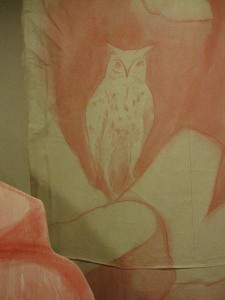
Mazeppa draws together the playfully larger-than-life elements in his work with a giant rocking horse, and a colorful pink backdrop. Consistent with themes in his other work, the piece explores the pain of the solitary mythical figure. The artist wrote in his statement that the stationary rocking horse is like a cruel reminder that the struggle is pathetic, repetitive, masturbatory, and despairing. In an email Kelly said he does not personally identify with every aspect of Mazeppa’s story, but had long sought to explore a “Byronic Hero.” He added that the theme in the poem which most appealed to him was that “this young man was stripped bare, and sent off to an uncertain future, and despite the odds survives and thrives.”
Fleisher’s Wind Challenge 1 will be up through October 20. Kelly is holding an encore performance of his Mazeppa piece October 6 at 4 p.m.


